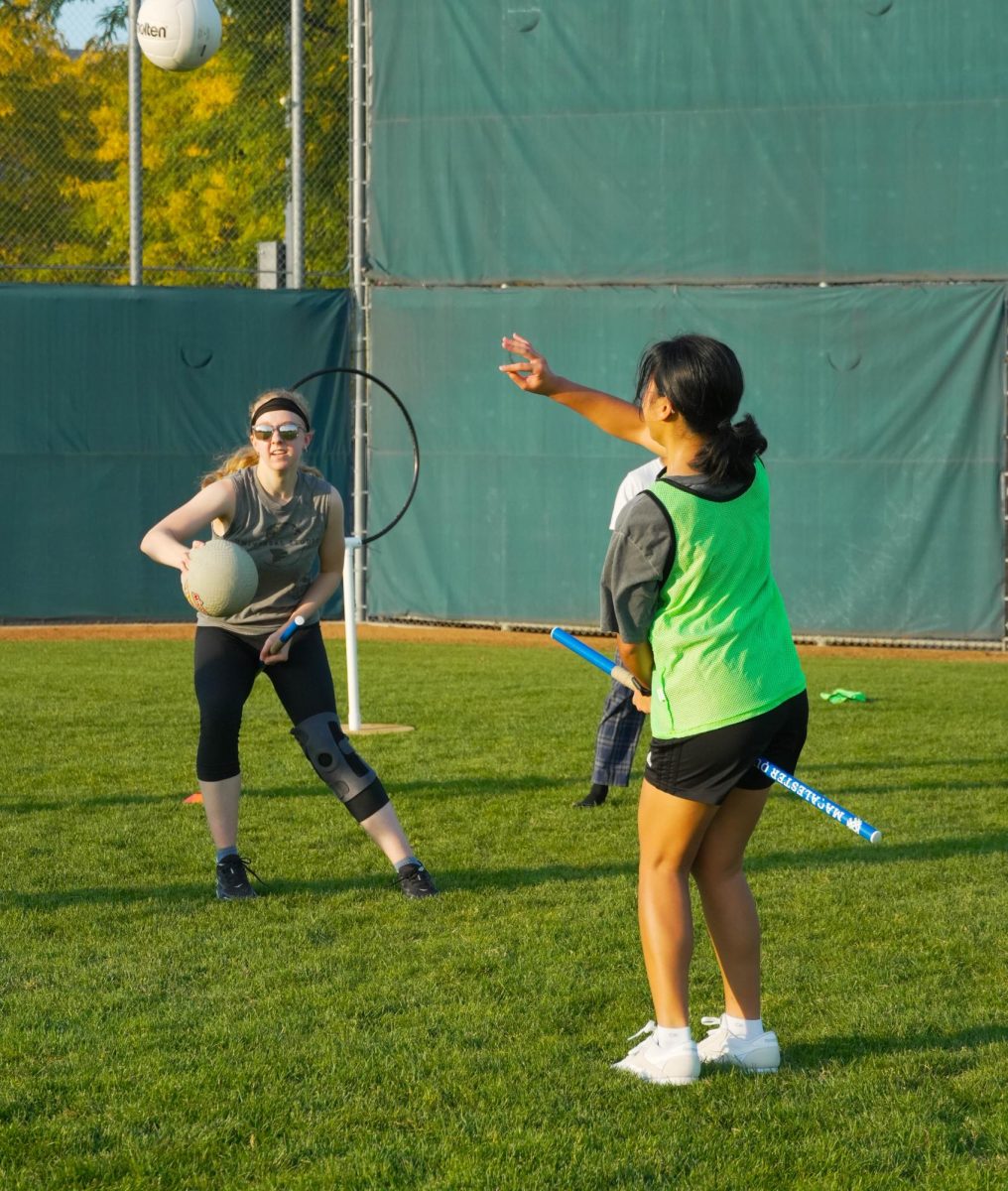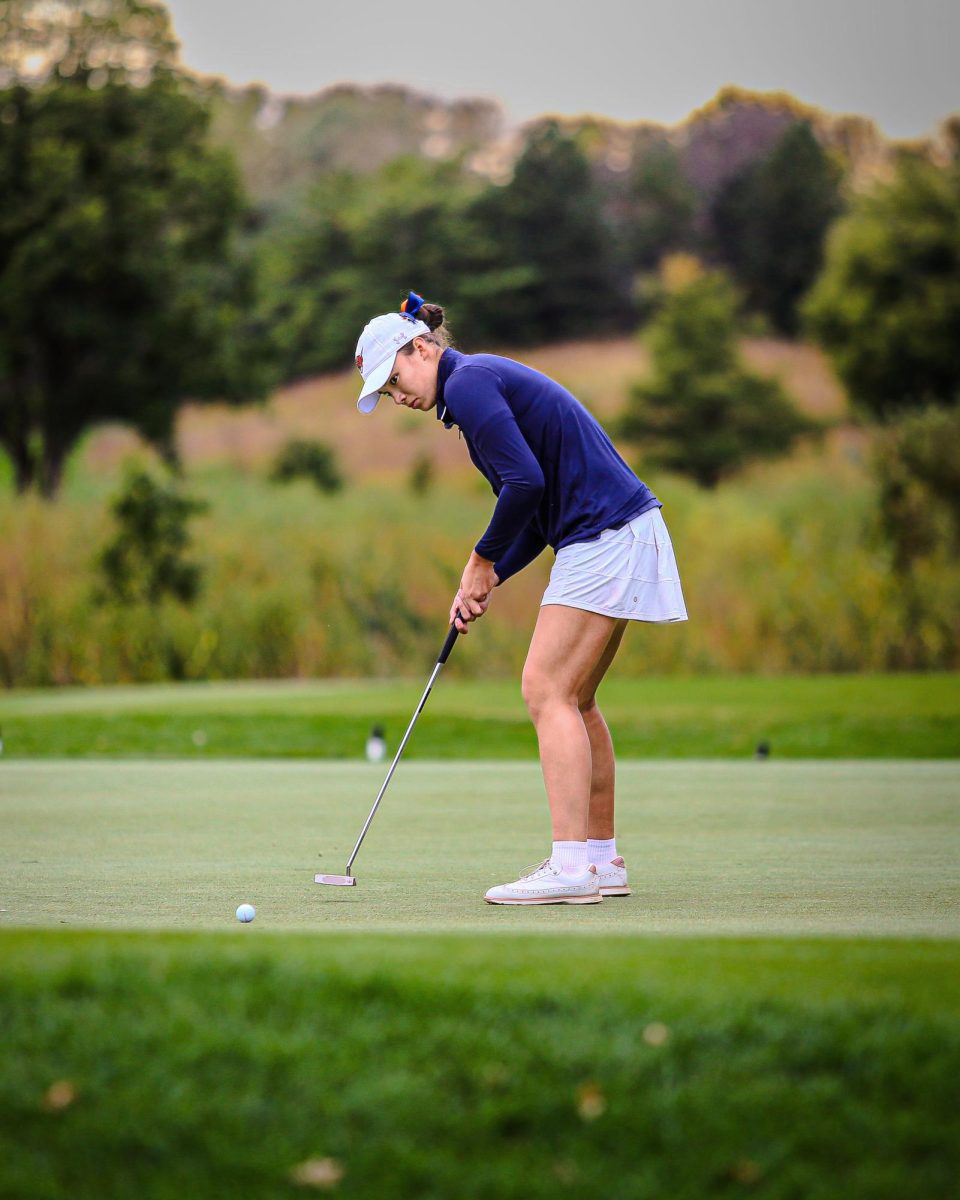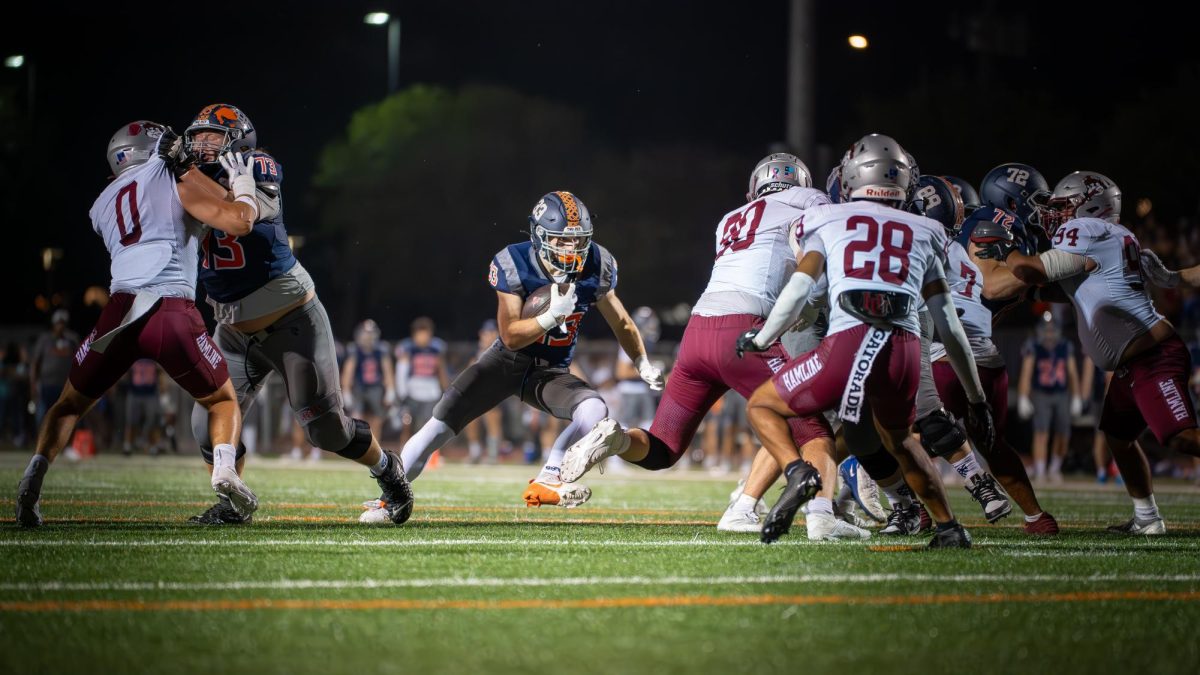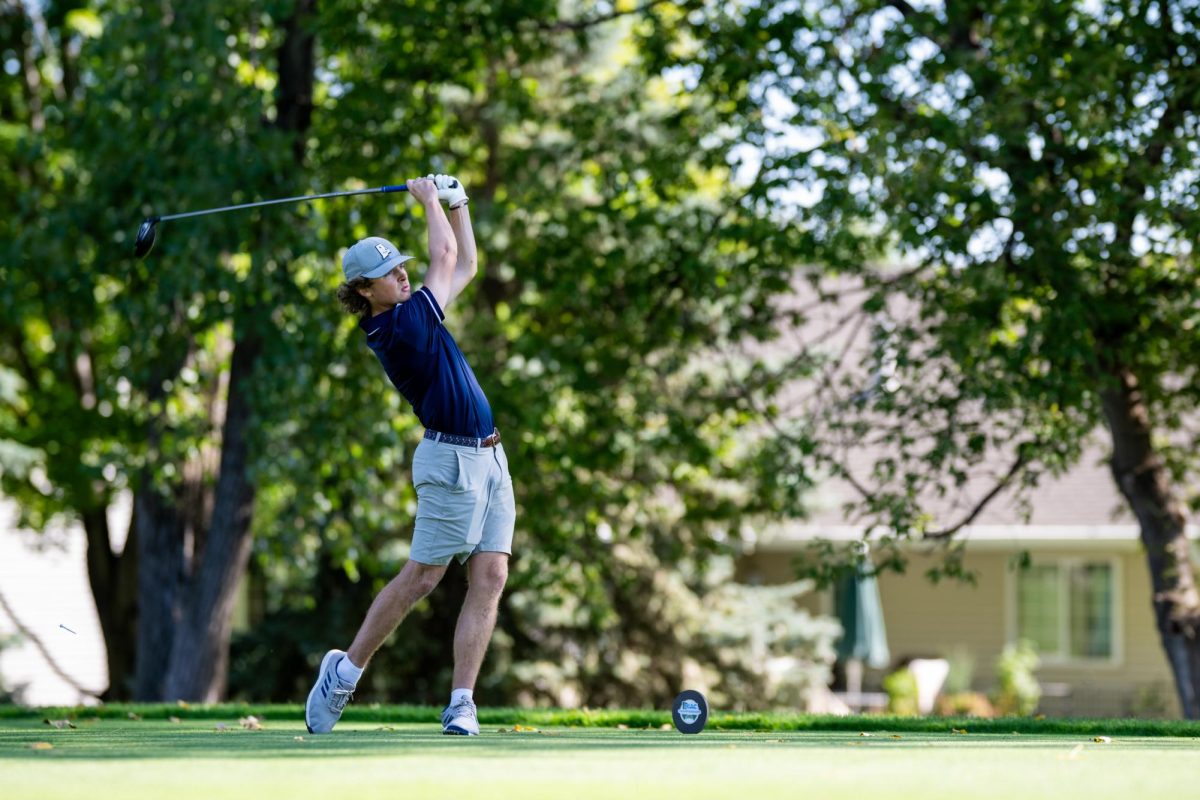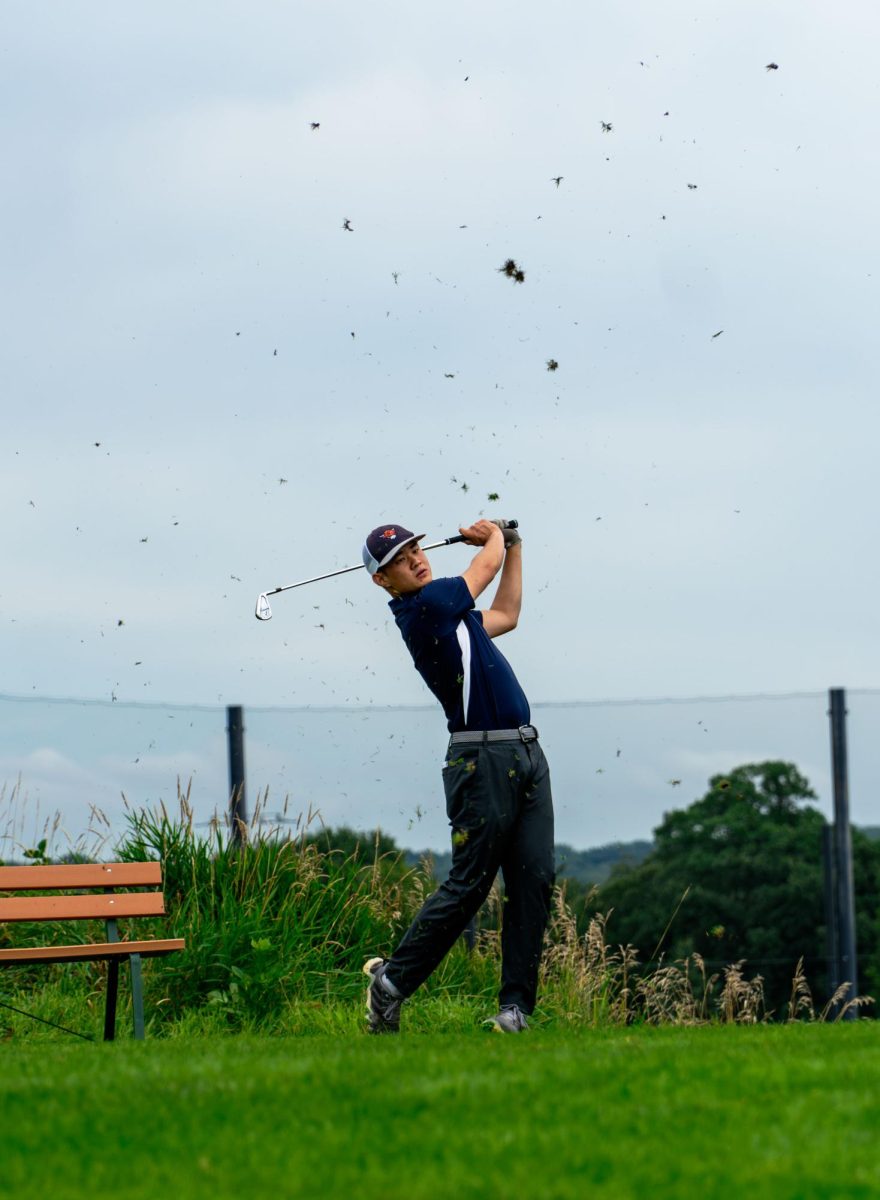If you’ve walked past the language houses on certain evenings and looked over towards the baseball and softball fields, you may have spotted one of Macalester’s most unique athletic offerings: a seven-a-side sport with similarities to basketball, soccer, handball and football, and a name you might not recognize. This is quadball, the youngest sport at Macalester, currently played at the club level.
The game draws its history back to 2006, when two students at Middlebury College in Vermont developed a real-world version of ‘Quidditch,’ from the world of Harry Potter, and gave their game the same name. The first intercollegiate match, between Vassar College and Middlebury, was held in November 2007, and from there, the sport spread like wildfire to college campuses around the country, including Macalester.
In The Mac Weekly’s third issue of 2008’s fall semester, exactly 15 years ago to the current issue, a sports article evidenced a buzz on campus surrounding starting a league, but, at the time it was written, there was seemingly no actual play. Evidence exists from 2011, four years later, of a quadball club that emerged and seems to have found immediate success in generating popularity, with some 160 sign-ups early on for the club. At some point, however, that club stopped play, and it wasn’t until 2021 that Alexandra Jabbarpour ’23 founded the current iteration of Macalester’s quadball team.
Quadball is played seven-a-side, with a general goal for one team to throw a ball into one of their opponent’s set of three elevated, horizontal hoops located at each end of the field. Players are split into four roles on each team. Each side has one keeper, who guards their team’s hoops, three chasers, who look to score by getting the quadball (typically a volleyball) through one of the hoops, two beaters, who can temporarily eliminate opponents by hitting them with dodgeballs and one seeker, who looks to capture the ‘snitch’ — a flag football flag attached to a neutral athlete who runs around the field starting after 20 minutes. A goal is worth 10 points, and catching the snitch is a feat worth 35 points. The central element of these rules, and the part that sets it apart from any other sport is that its players must at all times run with a broom between their legs. The end-condition of the game is similar to the Elam ending in basketball — at 20 minutes, the referee calculates a score 60 more than the current leading team’s tally. Once a team reaches that score, the game ends.
Even for sports fans, these rules are completely foreign. As opposed to more established sports, nobody gains an understanding of quadball through osmosis, as one might with baseball or soccer. In those and other sports, there may be an assumed level of knowledge, which creates a learning leap for those looking to begin with no experience.
Conversely, the assumed level of knowledge when going into quadball is zero. For co-captain Lilabeth Sokolewicz ’26, that’s a good thing.
“A lot of our team members came in with no athletic experience whatsoever, and I myself had never played any team sports,” Sokolewicz said. “My only sports experience is with dance, so I was about the least athletic person you can imagine coming into it. [Quadball is] just a really great kind of way to run around with your friends and get exercise and be outside, without the pressure that might come with expectations of knowing the rules to a sport. I was afraid to go to something like volleyball, even on the club level, because I hadn’t been playing and I didn’t know if I was expected to know what to do. But with quadball there isn’t that expectation, because almost nobody has played quadball before. So we learn the rules as we go.”
Like Sokolewicz, many of quadball’s members came into the sport, with no team sports experience at all. Phoebe Thomas ’26, who also had no team sporting experience before quadball, credits the shared skill level for creating an easygoing, low-pressure environment.
“I came into quadball with minimal previous sports experience, I’d done martial arts for many years but no competitive or team sports,” Thomas wrote in an email to The Mac Weekly. “Many people on the team are in the same boat, I would say most of us didn’t have much experience with team sports before joining quadball. It’s a very accessible intro to sports, because there are no expectations that anyone is coming in with prior knowledge of the rules, and people with any level of athleticism can play well and have fun (which is the main goal of practices).”
Jabbarpour noted that it was a top priority to de-emphasize the need for prior sport experience.
“The big thing is I’ve been very intentional in consistently trying to present quadball with its founding core values as being an all-gender club sport that is there for people with all different sports backgrounds or non-backgrounds,” Jabbarpour said in a recorded response to questions from The Mac Weekly.
Many participants described, joining the club on a whim because of friends and then getting wrapped up in the sport.
“I heard about it at the org fair in my first year,” team member Raina Tenenbaum ’25 said. “I played Quidditch back in middle school, believe it or not, so I was interested in playing, and then people I knew were involved, so I decided to go and I never stopped.”
“I joined quadball my second semester at Mac when I saw one of my friends at the table for it at the club fair,” Thomas wrote. “I had been slowly tempted into joining throughout the first semester because many of the people I was friends with happened to be in quadball, and I sort of followed them to practice and never left because I loved it. Now I’m going to five practices a week, half of which are at the University of Minnesota.”
That theme, of attending one practice and getting hooked, is in no small part thanks to what many recognize as quadball’s welcoming community.
“I would say the community is the most important aspect of quadball,” Thomas wrote. “I joined because of the people and they’re why I make going to every practice a priority. We make a conscious effort to include and support everyone who comes … be it at practice, in the group chat, or hanging out outside of quadball times. Most everyone is friends with each other outside of practices, and I found it to be shockingly easy to fit into the quadball community, even despite joining mid-year with no previous knowledge of the sport. It’s a space where I (and I hope everyone) can feel safe sharing how they’re feeling and know they’ll be supported by the community we’ve built.”
“I think it is an example of what the future of sports can look like,” Jabbarpour said. “And what all-gender sports can look like, while also having to be matched with good team culture, a supportive environment, and caring more about the well being and growth of our players.”
Quadball also offers a unique opportunity to witness the young development of a sport. Tactics are continually morphing in every sport, but in general, the concrete has dried for mainstream sports strategy — people will always innovate, but within established ranges. Quadball, having a history that stretches back fewer than 20 years, is still continually morphing, analogous to the early years of other tactically complex sports, like soccer, where tactics change constantly and at times unpredictably.
“It’s still a relatively young sport,” Sokolewicz said. “So the meta [an acronym for ‘most effective tactics available’] around the game is developing quickly and growing and changing every year.”
The beaters — players whose role is to roam the field and temporarily eliminate opponents by hitting them with a dodgeball — seem to be the site of the quickest tactical turnover, being the most unique and multidimensional position on the quadball field.
“It’s a pretty unique position, there’s not really anything similar in other sports,” Sokolewicz said. “There’s a lot more strategy based on having to decide when to throw your ball with the risk that you might lose it, but also with the benefit that you’ll probably take another player on the other team out of play. So it’s weighing that cost-benefit constantly, and also figuring out where you’re needed on the pitch and at what time, which requires a lot of awareness.”
The game as a whole, featuring four distinct positions across 7 athletes, sometimes seems completely disordered; a sense of quadball as ‘organized chaos’ seems to be a fairly common conception of the sport.
The elephant in the room for quadball is its recent name change from the original Quidditch. This occurred in July 2022, as an official action from the organizations now known as Major League Quadball and US Quadball, for two reasons. The first was to separate the sport from J.K. Rowling, the Harry Potter author who has come under heavy scrutiny in recent years for expressing anti-trans views, something which runs contrary to the philosophies of quadball. The second was to attempt to establish itself as a standalone sport, not a gimmick based on an existing piece of media.
Quadball is essentially unique among sports for how it handles gender. It is intentionally an all-gender sport and defines gender as strictly being how each individual player identifies themself. There is also an official rule that no team may have more than four players of the same gender on the pitch at the same time. In a time where sporting bodies have sought to codify and restrict gender within sports, often to the detriment of transgender athletes, quadball breaks norms by existing as an intentional, inclusive space.
When asked broadly about the community aspect of the club at Macalester, Tenenbaum specifically highlighted the gender-inclusive side of quadball.
“It’s in the rulebook that it’s an all gender sport, and it is directly in the rulebook that whatever gender the player identifies as is that player’s gender, end of story,” Tenenbaum said. “It’s a very welcoming community for everybody, especially for some people who may not necessarily be welcome in other sports. A lot of the other sports are gendered in certain ways, and it’s hard to play if you don’t fit into the traditional boxes of the gender binary.”
Jabbarpour also noted that gender inclusivity was an important part in creating quadball’s community.
“And it’s also been important that the gender component is also included in really valuing our trans and non-binary players too,” Jabbarpour said. “And for me, it’s been really nice to have people introducing names and pronouns for those who feel comfortable at every practice. And it was really nice to see.”
Quadball at Macalester also mirrors early sports in how competition occurs, where individual connections between clubs forms a major basis for competition, rather than more organized leagues. For an example of the first, Macalester’s rival, as in many competitions, is Carleton College. These two quadball clubs come by this rivalry, however, for a unique reason. The Alexandra Jabbarpour’s brother founded Carleton’s club, and the two teams play often. That familial aspect seems to lend a more friendly nature to episodes in this typically heated rivalry.
“Our scrimmages with Carleton in the past have been pretty chill,” Sokolewicz said. “We’ll usually play one game as Macalester vs Carleton, and we’ll do a second game where it’s mixed teams, just to have fun and get experience playing with other people. That’s how it works at Mac.”
Establishing these inter-club relationships and getting consistent competition is an important facet of the path to improving play, and it’s something Macalester’s quadball club is actively pursuing. Playing with bigger local clubs, like University of Minnesota-Twin Cities’ side, has also been a way that Macalester players have gotten more experience.
“University of Minnesota does have a competitive team though that we are reaching out to more this year,” Sokolewicz said. “We’re in the process of planning an open practice day with them. Some of our team members, including myself, are playing with the U of M competitive team this year through a ‘foster’ program.”
Playing with and against teams from UMTC offers both more experience in general, and also more experience in a different style of play from Macalester.
“I think we might play the U of M this year,” Tenenbaum said. “They have an intramural and a competitive team. And they also play quadball as more of a contact sport than we do. So we’re not entirely sure if it’s gonna work out, but we’ll see.”
While the name change has thrown up something of a recognition barrier — quadball is not yet a commonly known sport under its current name — Sokolewicz believes the young game will move past it.
“I mean, you do get the question ‘what is quadball?’ a lot, Sokolewicz said. “But also, I think quadball has a lot going for it on its own, and as more people get to know it and recognize it and experience it, I think it will grow very quickly, and hopefully enter the national consciousness.”

